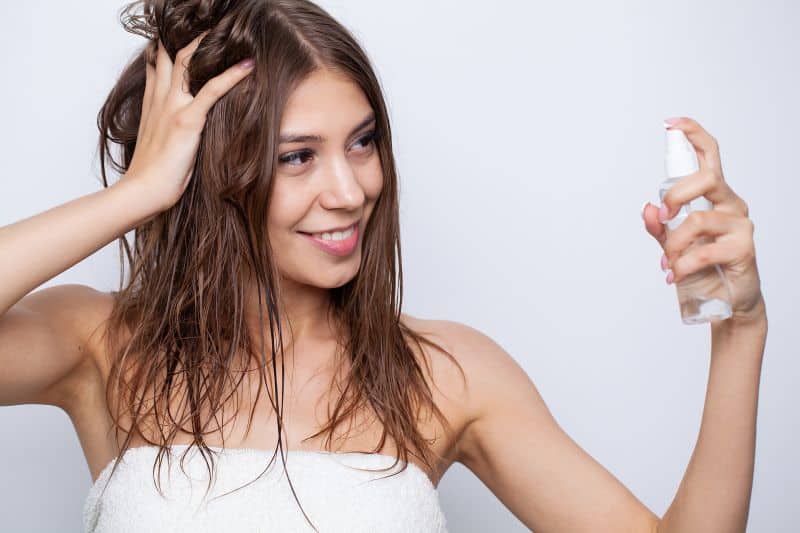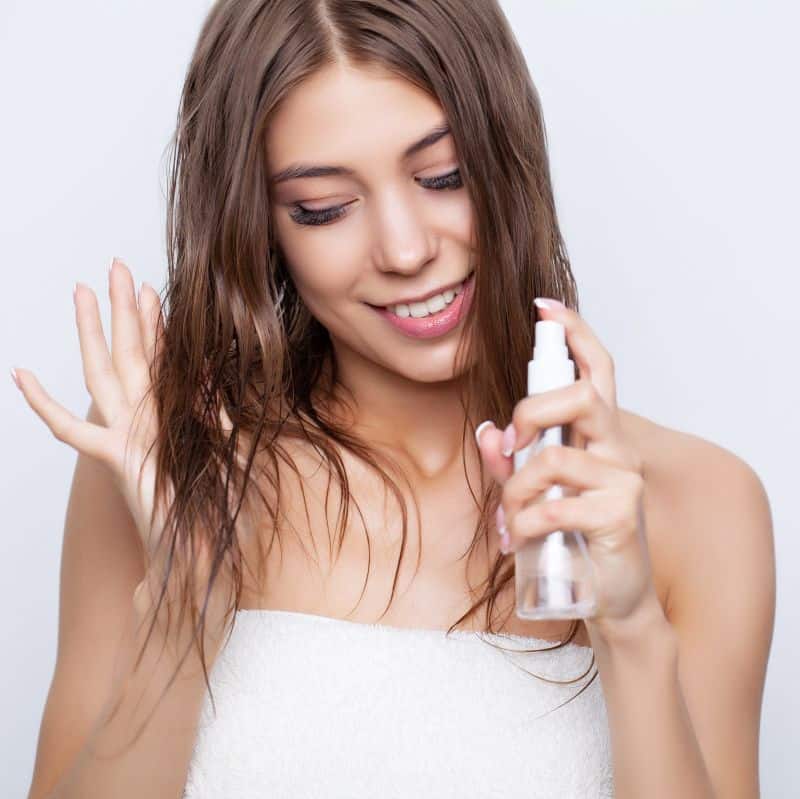Last Updated on February 15, 2023 by Gaga
What is Sealing Oil?
Sealing oils, also known as coating hair oils, don’t readily penetrate the hair shaft. This type of oil sits on the hair surface forming a water-proof barrier that prevents moisture from evaporating quickly. Sealing oils make hair shiny, frizz-free, and easy to comb through.
Oils that partially penetrate the hair, while partly staying on the outside of the cuticle layer, also have sealing abilities and can be used for both conditioning and sealing the hair. By understanding which oils have sealing properties, you will be better equipped to incorporate the right oils into your hair care routine.

Penetrating vs Sealing Oils
Neither penetrating nor sealing oils contain water. Oils are emollients which means they help your hair retain moisture from water or water-based products for a longer period of time.
Sealing oils have large-sized molecules that can’t penetrate the hair shaft. Instead, these oils form a protective coating around the hair strand that locks in moisture and prevents hair from damage.
On the contrary, penetrating oils are smaller in molecular size and can pass through the cuticle layer as a result. They also temporarily coat hair strands, but this coating is absorbed fast by the hair. Both penetrating and sealing oils help hair retain water content longer.
There is no clear distinction between penetrating and sealing oils. For example, many oils can partially penetrate the hair despite some oil content remaining outside of the hair strands.

How to Know what Kind of Hair Oil to Use?
Knowing what kind of hair oil to use depends on the condition of the hair and the reason you plan to use the oil.
If you are aiming to keep your hair well-conditioned, reduce friction, or minimize the appearance of tangles, a sealing oil is the best option for your hair goals. This type of oil lubricates the hair to make combing effortless while reducing frizz and making hair smooth and shiny. Since oils don’t contain water, you should apply sealing oils only after you’ve moisturized your hair.
If your goal is to protect the inner hair structure from the negative effects of frequent shampooing, high heat, and chemical damage, opt for a penetrating oil. This type of oil is a good choice for pre-washing because it protects the hair from the drying effects caused by shampoo and prevents your hair from absorbing excessive amounts of water.

How to Seal Your Hair with Oil
Since the purpose of sealing is to lock moisture inside the hair shaft, your hair must be slightly wet before you apply coating oil. To do so, wet your hair with water or apply a water-based hair product.
Apply a few drops of oil to your damp hair and rub the oil through the hair to its ends with your fingertips or use a comb to distribute it.
People commonly seal their hair after washing, but those with dry hair may need to seal their hair more often, especially the hair ends which are more prone to dryness. Hair ends are the oldest and most dry part of the hair and thus need the most attention. It takes some time for the oil to settle after application and during this time, the hair should be touched and manipulated in other ways.
What Oils Work for Sealing Moisture in the Hair?
1. Jojoba Oil for Sealing Hair
Jojoba oil has a waxy texture, and it closely resembles the sebum produced by sebaceous glands which keep hair moist and shiny. This oil does not have a high penetration power, but it works well as a sealant to protect hair against dryness. It also balances your scalp’s pH, dissolves sebum build-up, and helps combat dandruff. Jojoba oil is an ideal oil for dry and curly hair. Because curly hair slowly distributes natural oil along the length of hair strands, the use of jojoba oil can compensate for the lack of sebum.
How to use: The simplest way to use jojoba oil for sealing purposes is by adding a few drops of oil to your conditioner. You can also use pure jojoba oil as a leave-in conditioner by applying a small amount to damp hair with your fingertips. If you have thick and coarse hair you can use more oil, while people with fine hair should apply less oil and concentrate its use on the ends of the hair.
2. Grapeseed Oil
Grapeseed oil is a lighter oil that boosts hair shine and calms static and frizz. Its lubricating properties help prevent tangles and make the hair easy to comb through. This oil doesn’t leave hair looking greasy which makes it ideal for sealing hair. It is suitable for all hair types and is a common ingredient in a variety of hair products.
Thanks to the high proportion of linoleic acid and the low content of monosaturated lipids, grapeseed oil remains on the surface of the hair – retaining moisture and improving shine. When you use pure grapeseed oil as a leave-in product, it preserves moisture and protects hair from breakage. When applied to the ends of your hair, it instantly polishes split ends.
How to use: To reduce frizz, tame flyaways, and increase shine, apply a nickel-sized amount of oil to damp hair and comb through.

3. Almond Oil
Because it is lightweight, almond oil is suitable for use as a finishing oil. It can be used as a sealant for all types of hair, notably on fine hair which doesn’t tolerate most other oils. The high content of fatty acids repels UV rays, protecting hair from damage while the high content of polyphenols, vitamins, and minerals makes it suitable for scalp massages and boosting the circulation of the scalp.
If you want to restore shine and softness to overprocessed and lifeless hair, almond oil is an excellent choice. This oil is an effective hair sealant after washing and can be applied to the ends of the hair the next day as well.
To keep your scalp healthy and stimulate hair growth, apply oil to the scalp and let it sit for some time before washing.
How to use almond oil to seal hair: To remove frizz and protect hair from damage during combing and hot styling, it is best to use almond oil after washing and before styling your hair. If your hair is thick and frizzy, applying oil to the ends more frequently will offer the most benefit.
4. Avocado Oil
Avocado oil has a slight penetrating capability, so it can be successfully used as both a sealant and an ingredient in hair masks. The protective film that avocado oil forms around the hair preserves moisture, reduces the possibility of hair breakage, and protects the hair from damage.
To alleviate scalp dryness and flaking, add a few drops of avocado oil to your shampoo.
When used on dry, curly hair, apply oil to the entire length of the hair, braid it, and leave it in overnight.
How to use: Apply the oil through the mid-shaft focusing on the ends of your hair. Your hair will be softer, shinier, and easier to comb through.
5. Castor Oil
Castor oil is extremely versatile and is highly valued as a hair oil. Although there is limited research on the benefits of castor oil, it is traditionally used to stimulate hair growth. It is rich in omega 6 and 9 fatty acids and vitamin E. It has antifungal and anti-inflammatory properties which help keep the scalp healthy and reduce the appearance of dandruff. Due to the large size of its molecules, this oil is suitable for use as a hair sealant. Castor oil has a high viscosity and is not suitable for fine hair that is more prone to looking greasy and weighted down. However, castor oil is an excellent sealant for thick, curly, or processed hair and works to prevent dryness and keep curls soft and shiny.
How to use castor oil as a sealant: Apply a small amount of oil to damp hair after using shampoo and conditioner. Focus on the ends of the hair as this oil can weigh down hair if you use it heavily on the scalp.
6. Coconut Oil
Coconut oil is both a penetrating and coating oil because of its limited ability to penetrate the hair. This property causes excess oil to remain on the surface while coating the hair. Coconut oil has a wide variety of uses for the hair and scalp. Most notably, it can protect hair from protein loss when hair is exposed to chemical treatments.
As a pre-shampoo treatment, coconut oil prevents hair from drying out and soaking in excessive amounts of water that may cause damage to the hair.
By coating hair after washing, coconut oil reduces friction, makes combing easier, and hair softer. To make your hair look shiny, healthy, and frizz-free, apply a small amount of coconut oil after using shampoo and conditioner. Focus on the ends of your hair to minimize the appearance of split ends and reduce the need for frequent trimming.

Gaga is a blogger and founder of the Softer Hair website. She often says that insomnia is to blame for her first blogging attempts. Being the night owl, she hated the morning alarm. She left her office job and returned to what she loved most - writing.

